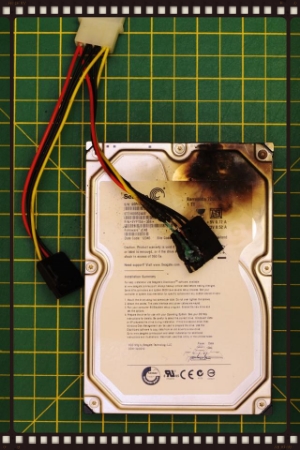As a professional wedding photographer I regularly deal with thousands of image files from any one day’s shooting – often covering events that are unique, without the possibly of a re-shoot. Therefore, it cannot be stressed enough the importance I place on the storage of the images I’m entrusted with...I shudder just thinking about having to ever go to a couple and inform them I’ve lost all the visual memories from their Special Day.
Why bring this up you might ask?
Just last week one of my hard drives had a catastrophic meltdown – a drive which stores ALL my client and personal images! Thankfully, because I adopted a hard drive mirroring facility (where the data on one drive is duplicated on another in real-time) the only inconvenience I had was that of money (for the cost of replacement drives) and time (waiting for the replacement drives to arrive and installation). However, had I not foresaw (and invested) in such a safety mechanism, this would be a very much different blog post.
It’s not just the short and long term storage of images which I take into consideration. It starts with the actual capturing of the images on the Big Day. I have more than one camera body, multiple lenses covering a variety of focal lengths, investment in pro-level camera bodies and lenses and I don’t store all the photos on one high capacity memory card; I split them over a number of 8GB & 16GB cards – so that if one card is lost or fails I only lose the images on that card and no the whole days shoot
Next is the post-shoot workflow processes for images storage. As soon as I arrive home after a day’s shooting (after demolishing some fast food) I import all photos from the memory cards onto my PC with one copy going onto my mirrored drive and another on an external network drive. Copies are also archived on a physical backup (DVDs), which is stored at a separate location the next day; I won’t format the memory cards until all backups have been stored and checked.
Once I’ve processed the wedding photos and delivered them to the client I’ll purge my main drive leaving only the hi-res final images, album design and accompanying files; with a copy of the complete final output being stored again on DVD and a network / cloud drive (along with the original raw backup). Also, for those couples who have purchased a licence to print the images I give them two copies – one to put in a safe place and another for taking to friends and family or printing.
This all may seem a bit over the top (and it is, until you need it), but in this day and age people rarely print images (even I’m guilty of this) and keep images in digital format on their phones, tablets or laptop – not giving much thought to what would happen if those devices were lost or damaged. For the typical person, if they had encountered a disk failure there would probably been no recovery of those images, which could have resulted years’ worth of irreplaceable memories being lost. So my advice to anyone is to regularly backup your photos, and print them – or do something with them; in terms of entrusting someone with your wedding photography – ask what safeguarding procedures they have in place for wedding photos, and what long-term storage policies they have.
